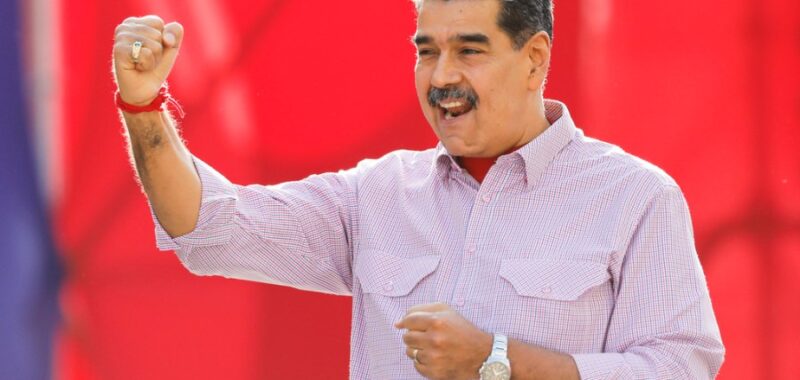
Last month, the U.S. imposed a 25 percent tariff on Venezuelan oil — a direct response to Nicolás Maduro’s refusal to take back thousands of deported Venezuelan migrants, including known members of the violent Tren de Aragua gang.
It was also a response to years of deliberate efforts by the Maduro regime to dismantle democratic institutions, undermine electoral legitimacy, cripple the economy through mismanagement, and enrich insiders through corruption — actions that have fueled the largest displacement crisis in the Western Hemisphere.
More than 7.7 million Venezuelans have fled the country, destabilizing an entire region and placing immense pressure on neighboring states and humanitarian systems.
At first glance, the new U.S. tariff may look like just another foreign policy move. But this one cuts deeper. It strikes at oil, the Maduro regime’s only remaining “legitimate” source of hard currency. And if it holds, the scaffolding upon which the regime has relied for years will start to buckle.
Even more striking is the language tucked into the measure: the 25 percent tariff isn’t limited to Venezuela alone. It may apply to any country that continues to import Venezuelan oil — whether directly or through intermediaries. That includes China and India, two of Venezuela’s largest buyers. If enforced, this would amount to a global quarantine of Venezuelan oil.
Few countries will risk a 25 percent tariff on their exports to the United States just to maintain access to cheap crude. In effect, the U.S. is treating Venezuelan oil like a contagion — and daring others to touch it.
Some in the Venezuelan opposition may see this as their latest chance to bring down the regime. But they always think the next thing will do it. I doubt it.
Oil isn’t the only lifeline keeping the regime alive. Drug trafficking and illicit trade now produce for it as much funding if not more. So the tariff may turn up the heat, but it won’t touch those illicit revenue streams, nor will it disrupt the operations that sustain them.
What we’re likely to see instead is a rapid tightening of cash. Payments to civil servants, retirees and the military could stall. Inflation will spike. Fuel, medicine and essentials will become even more scarce. Paranoia may take hold inside parts of the regime as whispers turn to plots — but there are always plots. Public frustration will boil over again.
Within months, the pressure could hit a breaking point. The regime will scramble for cash. Factions may splinter. Trust evaporates. Desperation takes over. Blackouts, food riots and deeper state dysfunction could follow. The regime might fall — but more likely, it will find a way to survive. It always has.
There’s a road map full of warning signs — a kind of weather gauge for a troubled regime. Repression will intensify. They will squeeze the last value from what remains — rushing gold sales, destroying the environment, especially in the Amazon basin.
If things get worse, Maduro will reach for lifelines — Moscow, Tehran and Beijing. But even his allies are losing interest in underwriting failure.
If the regime gets truly cornered, expect one final, brutal move: weaponized migration. Maduro will force out another 2 million to 3 million people in a calculated act of retaliation — not because conditions have deteriorated, but as a deliberate strategy to overwhelm neighboring countries, collapse fragile social welfare systems and pressure international humanitarian agencies.
The international response will likely be fragmented and slow — especially given the recent cuts in global humanitarian assistance by the Trump administration. And all eyes will be on Team Trump.
The regime’s goal would be to force the U.S. to rescind the tariffs by generating regional chaos. The Trump administration will face harsh scrutiny — both for supposedly triggering the collapse and for failing to prepare for the overwhelming humanitarian crisis that follows.
Any support offered in the aftermath will likely be viewed as too little, too late. Whether that blame is fair or not, it will be loud and incessant.
Let’s be clear about the type of regime we’re dealing with: You don’t drive one in four citizens out of your country by accident. The exodus didn’t result from war or natural disaster — it was engineered.
What we’re witnessing isn’t just state failure — it is criminal sovereignty, a government no longer serving its people but instead operating as a criminal enterprise with the protection of state power. Maduro’s regime that controls territory, commands armed forces and cloaks itself in national symbols — draped in a flag, shielded by sovereignty and still holds a seat at the United Nations. Maduro and the regime have not survived by governing. They have survived because oil kept flowing. Sanctions came and went, but buyers kept buying — corruption always found a way. The international community talked, but rarely acted.
They also auctioned off what remained of the state to generals, gang leaders and foreign backers. In return, they’ve shielded Maduro and the regime from collapse. That calculus is being challenged again.
But when survival is on the line, this regime will sacrifice its own people. It already has. If we blink, the regime adjusts and reconfigures.
Venezuela is lost. If we hold firm, it could crack under the weight of its own incompetence and greed. And if it cracks, we must be ready — not just for the flood of people or the power vacuum, but for the opportunity to help Venezuelans reclaim their country from the wreckage.
But the U.S. must act now — by maintaining financial pressure, preparing for the fallout and leading a regional response before chaos makes the decision for us.
Ron MacCammon, Ed.D., is a retired U.S. Army Special Forces Colonel and former political officer at the U.S. State Department. He has lived and worked in Latin America for more than 20 years and was assigned to the U.S. Embassy, Caracas, Venezuela 1999-2002. He has written extensively on security, governance and international affairs.

